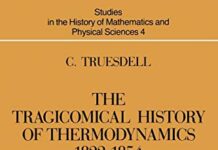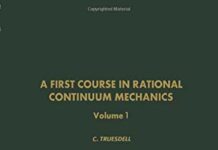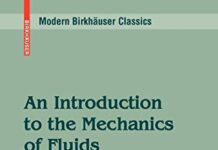
Ebook Info
- Published: 2012
- Number of pages: 384 pages
- Format: PDF
- File Size: 65.71 MB
- Authors: C. Truesdell
Description
This volume collects my shorter articles on the history of mechanics, some already published in various places, some revised from earlier papers, and some never published before. All of them began as lectures, and here they are printed as such, little changed from the last times I read them out to an audience. While the several articles concern different aspects of mechanics, overlap and even some repetition could not be avoided, since mechanics is one great science, and the same original oftentimes served more than one end in its growth. My three major historical treatises, which were published in Volumes (II) 11 , 2 12, and 13 of L. Euleri Opera Omnia, are not included. To simplify the printing I have also mostly omitted detailed reference to sources discussed more fully in those treatises, but of course I have added to the texts of the lectures citations of other sources, some notes in answer to questions a reader might ask, and biblio graphical notes at the end of each. I am grateful to the U.S. National Science Foundation for its support of this work through a grant to The Johns Hopkins University.
User’s Reviews
Reviews from Amazon users which were colected at the time this book was published on the website:
⭐This is a collection of essays. Each of them are brilliantly written, and each of them is full of information and also interpretation. This interpretation is precious because Truesdell has carefully worked through original writings, so any statement he makes is not his repeating some idea that is commonly said but poorly understood, but is saying his opinion after having chewed on an idea. (By analogy, it is a staggering problem to sort out if Newton’s second law is making a statement about two known phenomena, force and momentum, or if it is in fact merely a definition of the word force, and this problem is thoughtlessly ignored when this law is typically explained.)The first essay in this collection, “The Mechanics of Leonardo da Vinci”, is 83 pages long. I suspect that it is the most reliable reference on Leonardo’s mechanics that exists. Truesdell brought four tools to this study: he knew Italian well; he read the manuscripts carefully; he knew mechanics masterfully; and he had a good knowledge of what mechanics was known at Leonardo’s time. This essay is a treasury of ideas to develop for a historian of science or art. Two examples are: “Leonardo’s image is kinematic, not dynamic. He shows us motions, with little or no grasp of the forces that give rise to them.””Although Leonardo’s remarks on the principles of motion are closer to Western science than are the views of the literary humanists, they seem to be mere garblings of university commonplaces, perhaps picked up in conversation. Indeed, they remind me of the views of modern poets on quantum theory and nuclear fission.”Truesdell is also selective with the references he gives: he cites what he has read and considers good, or mentions those works that are considered standard and that he thinks are bad (this applies to all Truesdell’s writing; for this essay on Leonardo, he does not have anything good to say about Mach). He does not cite anything that he has not read or has only skimmed merely to prove that he is familiar with the literature on a topic.Truesdell’s writing is so excellent that I give two more quotes, for my own benefit if I read this review later and for anyone reading this review who may not have access to the book:”The scientist who approaches Leonardo da Vinci in terms of reason draws upon himself indignation from all sides. He must face a hydra: the common false ideas of what science is, the common puerilities on the history of science pattered ad infinitum in textbooks and histories and hence believed as unshakeable gospel by scientists, and, worst, the common boundless hero-worship of Leonardo as a universal genius of superlative though otherwise vague achievements.””If Leonardo is not the towering genius, the all-prophetic wizard of his popular image, this is no reproach. The fault lies not in him but in the eager credulity of the unscientific, who insist upon regarding science as magic, revealed through mystic inspiration to seers who are then enshrined as objects of minutial veneration… To clear away the preposterous popular image of Leonardo is not a mere exercise in debunking but rather a preliminary, unfortunately a necessary one, to a sober study of what he really did in natural philosophy.”
⭐The leitmotif of these essays is a critique of overextensions of the epithet “Newtonian”:”It is [not] the primitive mechanics of Newton … that we are taught as the most successful, the most thoroughly proved and understood, and the most perfect of the sciences of nature—the prototype and paradigm of a mathematical theory from physical phenomena. Rather, it is the easier parts of the rational mechanics of the Bernoullis, Euler, and their successors.” (p. 87)Indeed, when Euler, in 1750, published for the first time the general vector equation F=ma “as the axiom which ‘includes all the laws of mechanics'” (p. 257), he announced this as “a new principle of mechanics”; whereas today of course this is considered the defining emblem of “Newtonian” mechanics.”The modern student may find it hard to understand how sixty years of experience with special cases had to follow [the Principia] before this simple conclusion, which he is taught to accept unquestioningly in a first course in physics, was seen. … No-one [during these years] doubted the correctness of ‘Newton’s second law’, at least as a rule for problem-solving, but what no-one saw, until it was shown, was that among all the various mechanical principles then used it was the one which was general: It applies to every part of every system, and more than this, it suffices to get all the equations determining the motion of many systems.” (p. 116) “It is an incontestable fact that more than sixty years of research using more complicated methods even for rather simple problems took place before this ‘new principle’ was seen.” (p. 117)But this is not all. Euler soon changed his mind and reached the conclusion that his “new principle” did in fact not include “all the laws of mechanics” after all. Rather, the law of moment of momentum must be considered an independent, additional law of mechanics, reducible to F=ma only in special cases:”The tenet that Newton’s Laws or the ‘Newtonian’ equations in any of their forms suffice, can be held only by those who limit their attention to mass-points, rigid bodies, and certain other special systems. … But in elasticity Newton’s laws never have been and never can be sufficient” (p. 260); instead “everyone in the eighteenth century who studied problems of elasticity invoked the principle of moments” (p. 262), which Euler “laid down … as fundamental and independent” (p. 172).
⭐
Keywords
Free Download Essays in the History of Mechanics in PDF format
Essays in the History of Mechanics PDF Free Download
Download Essays in the History of Mechanics 2012 PDF Free
Essays in the History of Mechanics 2012 PDF Free Download
Download Essays in the History of Mechanics PDF
Free Download Ebook Essays in the History of Mechanics




